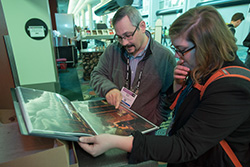News From Mark Shanda, USITT President
The Impact Behind the Numbers
 In a world that seems to constantly strive for measurable outcomes, ongoing assessments, and metrics that justify investment and decision making, the question of how we measure impact has become critical.
In a world that seems to constantly strive for measurable outcomes, ongoing assessments, and metrics that justify investment and decision making, the question of how we measure impact has become critical.
Those of you in the Institute who work in higher education are being bombarded with requests for data to demonstrate student success and direct links to expected learning outcomes (ELOs) within your curricula. You are being asked, in part, to justify the value of the study of the entertainment industry and live performance as a collegiate experience.
Those of you in the Institute who work in the commercial sector must constantly keep your eye on the bottom line, and justify your return on investment (ROI) on nearly every dollar your business spends. Investment returns are not only measured in financial terms but in time spans that appear to becoming ever shorter as more immediate reward is so strongly desired.
For the leadership of the Institute, how we measure impact focuses on how the various programs and member opportunities we offer align with our mission to “connect performing arts design and technology communities to ensure a vibrant dialogue among practitioners, educators, and students.” While the drive for measuring impact appears to push us all toward some numeric value assessment of all that we do, I would like to suggest an alternative way of thinking about how what we do affects others.
While certainly not as easy to capture in a spreadsheet, pie chart, or statistical table, I believe that impact should be measured on a one-to-one, interpersonal basis. We should ask ourselves, “How did our recent production affect an individual audience member? What difference did our sales and service call mean to the arts community with which we worked? What change in practice resulted in the teaching of that last student? What did we each do today that made a difference in the life of another?”
My concern when we try to boil everything down to a numerical value is that we can easily overlook the human beings involved in the endeavor. The Institute makes choices to invest dollars in research, staff time for educational programs, and expanded avenues to provide volunteer engagement to impact people. The very heart of our organization is to change, challenge, and educate artists and technicians of every age to be their best, to bring an enhanced skill set to their next project, and to find fulfillment in lifelong learning and engagement in production.
As can be seen in the Institute’s soon-to-be-delivered annual report, we spent money, invested staff resources, and scheduled events that can be fairly easily counted. But behind all of those numbers is our most important impact: With each endeavor, we made a change in someone’s life.
I am proud to be at the head of the table for this remarkable organization and I anticipate that an even greater impact on people lies just ahead with new investments yet to be known.


We'd like to hear your comments on this story.
Please e-mail Mark at Shanda.1@osu.edu.